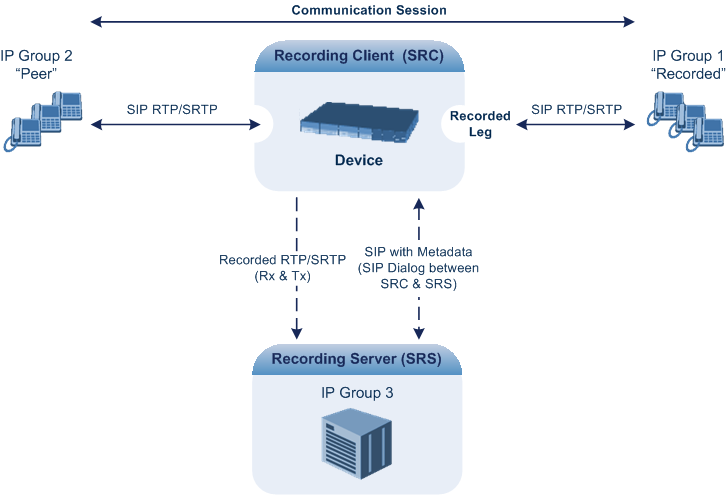SIPREC Overview
The device can record SIP-based media (RTP/SRTP) call sessions traversing it. The device can record not only audio streams, but also video streams for audio-video calls. The media recording support is in accordance with the Session Recording Protocol (SIPREC), which describes architectures for deploying session recording solutions and specifies requirements for extensions to SIP that will manage delivery of RTP media to a recording device. The device's SIPREC feature is in compliance with the following:
|
■
|
RFC 6341 (Use Cases and Requirements for SIP-Based Media Recording) |
|
■
|
Session Recording Protocol (draft-ietf-siprec-protocol-02) |
|
■
|
Architecture (draft-ietf-siprec-architecture-03) |
|
■
|
RFC 7865 (Session Initiation Protocol (SIP) Recording Metadata) |
Warning for Deployments in France: The device supports SIPREC according to RFC 6341. As such, you must adhere to the Commission Nationale Informatique et Liberté’s (CNIL) directive and be aware that article R226-15 applies penalties to the malicious interception, diversion, use or disclosure of correspondence sent, transmitted or received by means of telecommunication, or the setting up of a device designed to produce such interceptions.
|
●
|
The SIPREC feature is available only if your device is installed with a License Key (see License Key) that includes this feature. The License Key specifies the maximum number of supported SIPREC sessions. For audio-video calls, video recording needs additional SBC media channel resources. |
|
●
|
For maximum concurrent SIPREC sessions, refer to the device's Release
Notes (click here). |
|
●
|
The device can record the following media streams: audio only, text only, audio and video, or audio and text. |
|
●
|
You can view active and historical SIPREC call information, using the CLI command show voip calls. |
Session recording is a critical requirement in many business communications environments such as call centers and financial trading floors. In some of these environments, all calls must be recorded for regulatory and compliance reasons. In others, calls may be recorded for quality control or business analytics. Recording is typically performed by sending a copy of the session media to the recording devices.
The SIPREC protocol specifies the use of SIP, SDP, and RTP to establish a Recording Session (RS) from the Session Recording Client (SRC), which is on the path of the Communication Session (CS), to a Session Recording Server (SRS) at the recording equipment. The device functions as the SRC, sending recording sessions to a third-party SRS, as shown in the figure below.

The device can record calls between two IP Groups. The type of calls to record can be specified by source and/or destination prefix number or SIP Request-URI, as well as by call initiator. The side ("leg") on which the recording is done must be specified. Specifying the leg is important as it determines the various call media attributes of the recorded RTP (or SRTP) such as coder type.
